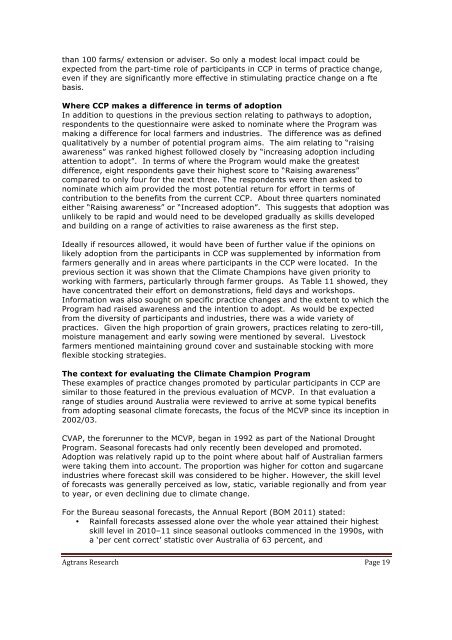An Economic Analysis of GRDC Investment in the Climate ...
An Economic Analysis of GRDC Investment in the Climate ...
An Economic Analysis of GRDC Investment in the Climate ...
You also want an ePaper? Increase the reach of your titles
YUMPU automatically turns print PDFs into web optimized ePapers that Google loves.
than 100 farms/ extension or adviser. So only a modest local impact could be<br />
expected from <strong>the</strong> part-time role <strong>of</strong> participants <strong>in</strong> CCP <strong>in</strong> terms <strong>of</strong> practice change,<br />
even if <strong>the</strong>y are significantly more effective <strong>in</strong> stimulat<strong>in</strong>g practice change on a fte<br />
basis.<br />
Where CCP makes a difference <strong>in</strong> terms <strong>of</strong> adoption<br />
In addition to questions <strong>in</strong> <strong>the</strong> previous section relat<strong>in</strong>g to pathways to adoption,<br />
respondents to <strong>the</strong> questionnaire were asked to nom<strong>in</strong>ate where <strong>the</strong> Program was<br />
mak<strong>in</strong>g a difference for local farmers and <strong>in</strong>dustries. The difference was as def<strong>in</strong>ed<br />
qualitatively by a number <strong>of</strong> potential program aims. The aim relat<strong>in</strong>g to “rais<strong>in</strong>g<br />
awareness” was ranked highest followed closely by “<strong>in</strong>creas<strong>in</strong>g adoption <strong>in</strong>clud<strong>in</strong>g<br />
attention to adopt”. In terms <strong>of</strong> where <strong>the</strong> Program would make <strong>the</strong> greatest<br />
difference, eight respondents gave <strong>the</strong>ir highest score to “Rais<strong>in</strong>g awareness”<br />
compared to only four for <strong>the</strong> next three. The respondents were <strong>the</strong>n asked to<br />
nom<strong>in</strong>ate which aim provided <strong>the</strong> most potential return for effort <strong>in</strong> terms <strong>of</strong><br />
contribution to <strong>the</strong> benefits from <strong>the</strong> current CCP. About three quarters nom<strong>in</strong>ated<br />
ei<strong>the</strong>r “Rais<strong>in</strong>g awareness” or “Increased adoption”. This suggests that adoption was<br />
unlikely to be rapid and would need to be developed gradually as skills developed<br />
and build<strong>in</strong>g on a range <strong>of</strong> activities to raise awareness as <strong>the</strong> first step.<br />
Ideally if resources allowed, it would have been <strong>of</strong> fur<strong>the</strong>r value if <strong>the</strong> op<strong>in</strong>ions on<br />
likely adoption from <strong>the</strong> participants <strong>in</strong> CCP was supplemented by <strong>in</strong>formation from<br />
farmers generally and <strong>in</strong> areas where participants <strong>in</strong> <strong>the</strong> CCP were located. In <strong>the</strong><br />
previous section it was shown that <strong>the</strong> <strong>Climate</strong> Champions have given priority to<br />
work<strong>in</strong>g with farmers, particularly through farmer groups. As Table 11 showed, <strong>the</strong>y<br />
have concentrated <strong>the</strong>ir effort on demonstrations, field days and workshops.<br />
Information was also sought on specific practice changes and <strong>the</strong> extent to which <strong>the</strong><br />
Program had raised awareness and <strong>the</strong> <strong>in</strong>tention to adopt. As would be expected<br />
from <strong>the</strong> diversity <strong>of</strong> participants and <strong>in</strong>dustries, <strong>the</strong>re was a wide variety <strong>of</strong><br />
practices. Given <strong>the</strong> high proportion <strong>of</strong> gra<strong>in</strong> growers, practices relat<strong>in</strong>g to zero-till,<br />
moisture management and early sow<strong>in</strong>g were mentioned by several. Livestock<br />
farmers mentioned ma<strong>in</strong>ta<strong>in</strong><strong>in</strong>g ground cover and susta<strong>in</strong>able stock<strong>in</strong>g with more<br />
flexible stock<strong>in</strong>g strategies.<br />
The context for evaluat<strong>in</strong>g <strong>the</strong> <strong>Climate</strong> Champion Program<br />
These examples <strong>of</strong> practice changes promoted by particular participants <strong>in</strong> CCP are<br />
similar to those featured <strong>in</strong> <strong>the</strong> previous evaluation <strong>of</strong> MCVP. In that evaluation a<br />
range <strong>of</strong> studies around Australia were reviewed to arrive at some typical benefits<br />
from adopt<strong>in</strong>g seasonal climate forecasts, <strong>the</strong> focus <strong>of</strong> <strong>the</strong> MCVP s<strong>in</strong>ce its <strong>in</strong>ception <strong>in</strong><br />
2002/03.<br />
CVAP, <strong>the</strong> forerunner to <strong>the</strong> MCVP, began <strong>in</strong> 1992 as part <strong>of</strong> <strong>the</strong> National Drought<br />
Program. Seasonal forecasts had only recently been developed and promoted.<br />
Adoption was relatively rapid up to <strong>the</strong> po<strong>in</strong>t where about half <strong>of</strong> Australian farmers<br />
were tak<strong>in</strong>g <strong>the</strong>m <strong>in</strong>to account. The proportion was higher for cotton and sugarcane<br />
<strong>in</strong>dustries where forecast skill was considered to be higher. However, <strong>the</strong> skill level<br />
<strong>of</strong> forecasts was generally perceived as low, static, variable regionally and from year<br />
to year, or even decl<strong>in</strong><strong>in</strong>g due to climate change.<br />
For <strong>the</strong> Bureau seasonal forecasts, <strong>the</strong> <strong>An</strong>nual Report (BOM 2011) stated:<br />
• Ra<strong>in</strong>fall forecasts assessed alone over <strong>the</strong> whole year atta<strong>in</strong>ed <strong>the</strong>ir highest<br />
skill level <strong>in</strong> 2010–11 s<strong>in</strong>ce seasonal outlooks commenced <strong>in</strong> <strong>the</strong> 1990s, with<br />
a ‘per cent correct’ statistic over Australia <strong>of</strong> 63 percent, and<br />
Agtrans Research <br />
Page 19

















